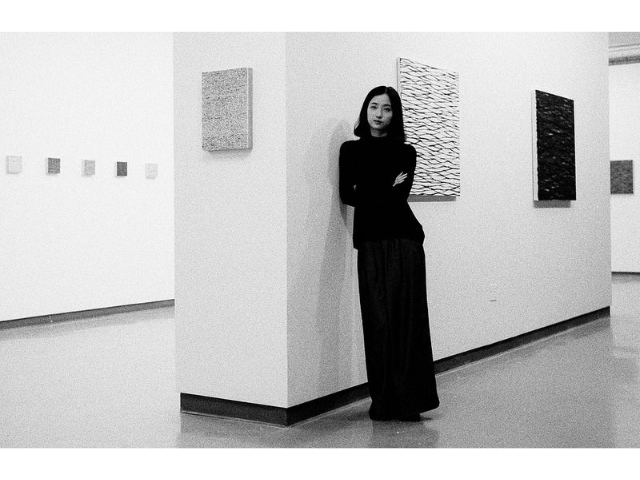
Artist-in-Residence Yingqian Cao: Using Savvy to Find the Essence of Art
On the surface, the patterns of Yingqian Cao’s works might seem alike. However, upon closer inspection are the subtle yet significant differences in lines, intensity, and energy. While the works create a meditative and sensitive atmosphere, this calmness is mediated by a confluence of various lines and variances that seemingly happen by accident, imparting feelings of uncertainty.
Such is the work of the contemporary artist’s exhibition for Pearl River Mart, The Illusion of Certainty, in which she explores nature and the changes and disruptions passing time can have on our precious environment.
We had the chance to speak with our latest artist-in-residence about western fact-finding versus Chinese “savvy,” expanding her identity beyond #painter, and the many forms of art.
I see from your website that you went to college in Tianjin. Is that where you’re from? If not, where were you born? Where did you grow up?
I was born in Jingzhou, a city with over 5,000 years of history in central China’s Hubei Province, one of the first nine provinces in ancient China. At the age of 10, my family and I moved to Shenzhen, the city that was designated China’s first Special Economic Zone in 1980 and later became the fastest developed city in the recent 40 years. The experience of growing up and living in both an ancient city and a modern city had a great impact on the way I think and my art.
One of our artists from China told us she was the only art student at her high school (everyone else was studying science). Did you experience something similar? What was your experience like?
High school students in China can choose their focus in science, liberal arts, sports, and arts. The high school I attended paid much attention to the diversity of student focuses. Therefore, I had a few fellow art students and a nice studio for us to practice. It provided me great opportunities to exchange ideas with other art students and tutors, which helped me build a solid foundation for figure drawing and painting. As for college, as you can tell from its name, Tianjin Academy of Fine Arts, everyone studies art.
Have you always been interested in art?
Yes. I started painting at a very young age when my grandma would draw the outlines of figures for me and I’d fill them with colors. When I was four and after my parents knew I was fond of painting, I had a teacher teach me basic painting skills. I kept painting as a hobby, practicing in my spare time until I became an art student in high school, which is when I started to paint full time and learn art in a systematic way.
However, even though I’m now a professional artist, I don’t deem art as a tool for me to make money. Neither do I deem it as a career. It is still my hobby, the thing I enjoy the most, through which I can explore the world and express myself.
What was your parents’ reaction when you decided to pursue art full time?
They have been my biggest supporters and fans ever since I started painting at the age of four. I feel lucky and grateful they both supported my decision. Actually, we made this decision of my being an artist together in a family meeting.
What made you decide to pursue a more abstract medium? Did you pursue other media before this?
I practiced figure drawing and realism painting for a long time before I went to college. It was in college that I began to learn and try different art styles. I was deeply influenced by one of my professors and the way he expressed feelings and emotion through abstract elements. That was the beginning of the formation of my current art style.
Another key event that influenced my art style was moving to New York. In my first semester at Pratt, I felt lost because of the new environment and culture. I had to take English classes which limited my time to paint. However, I never stopped thinking about art and life. Gradually, I captured through my thinking and feelings a sense of loneliness and tranquility, and many art concepts that I wanted to experiment.
I have also tried to remove the hashtag of “painter” from myself by exploring printmaking, photography, ceramics, and many other media. As you can see from my work, I convey a sense of tranquility by abstract gestures through many different media. Abstract gestures help convey the feelings since they don’t have a reflex in real life. In fact, I don’t wish the viewers to connect them with concrete items at all.
What made you decide to leave China? Why New York?
Living in different environments helps me view the world more completely and contemplate effectively. I was exchanged to Britain in high school for one month and lived in Norway for two months in 2014, and as I mentioned before, I grew up in both old and modern cities in China. I chose New York because it’s one of the most diverse cosmopolitans in the world, from where I can have access to the most recent contemporary art and many different interesting cultures.
Did you experience any culture shock when you first came to New York? What was that like?
There’s an essential difference between how Chinese and western people think of questions: western people find evidence and demonstrate facts before they draw a conclusion, which might be a legacy of ancient Greek science, whereas Chinese people just "savvy" (悟 wù), which is to find the inner essence first before expressing it in a proper way. It’s interesting to me that the angle from which I view something is different from or even contrary to that of an American.
What are some main differences you’ve observed between New York and China?
Compared to metropolitan cities in China such as Shanghai and Hong Kong, there is really not much difference. They all have modern buildings and parts that are historical. They all even have a similar skyline by a river. They are so similar that sometimes I have illusions that I’m still in China and it’s just a city with many foreigners. I guess another reason is that metropolitan cities all have great diversity in cultures and people.
Do you believe in inspiration? If so, what do you do to get inspired?
I do believe in inspiration. But it’s not about a single moment of inspiration or brilliance. What I do to get inspired is to keep thinking, experiencing different things, meeting more people, and most importantly, to never stop practicing and experimenting.
Is there anything in particular that’s inspiring you now?
My early works were inspired by natural things and organic shapes. Something recent that I’ve found inspiring is my boyfriend’s reading of the Tao Te Ching. Although he's the one who read the book and not me, he keeps talking to me about the theories, to the point that I got a little annoyed. (Laughs) Nevertheless, I believe that ancient wisdom influences me unconsciously.
My other inspirations are all from trivial things and random scenes from life. For example, glass reflecting on the ground or wall, a shadow on a curtain, traces left by water, etc.
What advice would you have for someone interested in pursuing art?
Be true to yourself and keep working on whatever you are working on. In my opinion, showing the essence of a thing in a proper way is art. This thing can be anything. A formula that a mathematician invents is art. A DNA sequence a biologist discovers is art. An iPhone is art, a Tesla car is art.
It’s important to keep delving into one thing until you finally “savvy” the essence. How to show the art will not be a problem at that point because it will come out naturally. However, simply pursuing the displaying form or output method is not the correct way to pursue art. Similarly, new forms of art shouldn’t be the thing to pursue if an artist is looking for breakthroughs. Focusing on the essence should be.
The Illusion of Certainty be on view in our TriBeCa mezzanine gallery from April 5 through through May 12, 2018. To learn more about Ms. Cao, visit her website.
